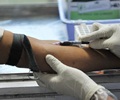A new paper published today in the journal AIDS has revealed low mother to child HIV transmission in the UK

Dr Claire Townsend (UCL Institute of Child Health) said: "Mother to child HIV transmission is now at the lowest level ever in the UK & Ireland, and as far as we're aware such low levels have never been reported on such a large scale."
The continued fall in transmission rates is thought to be due to a combination of factors including earlier initiation of antenatal combination antiretroviral therapy (cART) and an increase in the number of women already on cART when they conceive.
These new statistics are in line with the World Health Organisation's goal of virtual elimination of mother to child transmission by 2015. The dramatic fall in the transmission rate in the UK can also be attributed to a very high uptake of antenatal HIV screening, which is offered to all pregnant women, and a multi-disciplinary approach to the management of HIV positive pregnant women and their babies.
The study found that there was a marked decline in the proportion of diagnosed HIV-positive pregnant women who received no antenatal cART from 3.3% in 2000-2006 to 1% in 2007-2011 and an increase in the duration of treatment during pregnancy. A longer duration of treatment was significantly associated with reduced transmission risk.
The study also highlighted the extensive inequalities in the availability of interventions to prevent mother to child HIV transmission worldwide. In the UK 99% of diagnosed HIV positive pregnant women receive cART, whilst UNAIDS estimates that similar treatment regimes in West and Central Africa reach only 27%. The statistics within Europe also show a large gap in access to treatment with transmission rates as much as 4-10 times higher in some parts of Eastern Europe (0.46% transmission in the UK, compared to 2-4% in Russia and 4-5% in the Ukraine), where prevalence of HIV in pregnant women is higher and access to antiretroviral drugs more limited.
Advertisement
Advertisement














